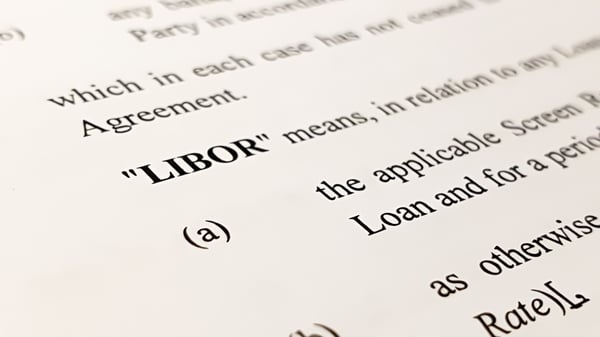The London Inter-Bank Offer Rate (LIBOR) has been the industry-wide standard for calculating variable interest rates for more than 40 years. This standard underpins more than $350 trillion in financial contracts. The Financial Conduct Authority announced the phase-out after weaknesses exposed during the financial crisis of 2008, meaning that these contracts must now be painstakingly reviewed and revised. The LIBOR transition scope is vast, but legal teams can begin moving away from the longtime standard in preparation for its 2021 expiration. With the right strategy and Artificial Intelligence (AI) tools, change doesn’t have to be a crisis.

What is Changing in the LIBOR Transition?
LIBOR will be replaced by an alternative reference rate—likely, the Secured Overnight Financing Rate (SOFR), designed by the Federal Reserve Bank of New York, the U.S. Treasury Office of Financial Research, and the Alternative Reference Rate Committee.
Ideally, contract updates will phase out LIBOR, and banks will no longer submit LIBOR estimates after 2021; the rate will simply cease to exist. Banks that persist in the old way will be referencing an inaccurate rate, and they could introduce substantial risk to the organizations involved.
What Corporate Legal Departments Need To Do
The transition from LIBOR will involve three phases:
- Assess the current contract portfolio.
In the first stage, legal teams will evaluate each contract and assess whether LIBOR pertains to it or not. Far from a simple “yes” or “no” answer, a deep understanding of asset classes will be necessary to complete this task. Variable interest loans that mature past 2021 are almost always linked to LIBOR, but even fixed-rate loan contracts can contain an interest rate derivative that links to it. Developing a framework of contract review questions can help address these intricacies.
- Next, interim amendments provide fallback language to fill the gap.
Some legal teams have moved immediately to incorporate SOFR into their contracts, while others are proceeding more cautiously and including soft fallback language for any contingency. Additionally, contracts with fallback provisions that address the temporary unavailability of LIBOR due to computer glitches or market disruptions should be flagged and revised for the permanent discontinuation of LIBOR. While there’s no time like the present to clean up weak fallback language, it can be a tedious task.
- Lastly, the replacement rate will need to be entered into the contracts.
Legal teams will update their contracts, systems, and processes for the new rate and train staff to address a new set of needs. As the regulatory framework changes, so should the playbook. The revised playbook should include parameters for counterparty communication to help unify the communication strategy and address inquiries as they arise.
How AI Can Ease the LIBOR Transition
Since the cost and labor associated with manual contract review can be daunting, corporate legal departments should consider the most efficient ways to tackle this transition. Innovative teams are investing in artificial intelligence (AI) that can automate many of the most arduous tasks.
AI solutions are characterized by:
- Accuracy - AI is well equipped to perform LIBOR contract reviews. The technology flags relevant contracts and sections that require amending. Advances in natural language understanding allow AI to accurately pinpoint which contracts are tied to LIBOR while reducing the risk of human error.
- Scalability - The precise passages that cite LIBOR can be flagged in a matter of minutes, whereas manual review could require hundreds, or even thousands, of hours. By suggesting changes according to AI Digital Playbook rules, AI solutions enable legal staff to focus on higher-value activities.
- Complexity - Machine learning helps AI identify the many phrases that cover fallback procedures and determine whether they meet standards for the discontinuation of LIBOR or whether they require updating to the new standard.
- Accountability - AI can quickly ascertain if all amendments have been processed using specific guidelines defined by the legal department. Changes can be set to track, which provides a helpful audit trail and increases confidence in the end result.
- Opportunity - Beyond the LIBOR transition, AI can be used in other portfolio-wide contract review processes to improve quality, lower risk, update best practices, and apply new regulatory standards. As a result, AI-powered contract negotiation helps attorneys close deals faster.
Although the sun is setting on LIBOR, a new dawn is rising for legal departments willing to modernize their contract review processes. Over the last five years, machines have evolved beyond mere pattern recognition to new modes of machine learning that mimic the neural wiring processes of the human brain. The newly-cracked code on computational linguistics based on aggregate data from thousands of contracts and human-defined playbook standards has led to exceptional results, whether preparing for the LIBOR transition or updating other contract parameters.
Contact LexCheck to find out how easy it is to implement AI for the LIBOR transition and beyond. To see our technology in action, request a demo.
.jpg)
